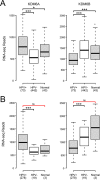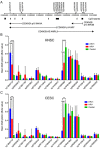Human papillomavirus dysregulates the cellular apparatus controlling the methylation status of H3K27 in different human cancers to consistently alter gene expression regardless of tissue of origin
- PMID: 29069809
- PMCID: PMC5641152
- DOI: 10.18632/oncotarget.19885
Human papillomavirus dysregulates the cellular apparatus controlling the methylation status of H3K27 in different human cancers to consistently alter gene expression regardless of tissue of origin
Abstract
High-risk human papillomaviruses (HPV) cause cancer at multiple distinct anatomical locations. Regardless of the tissue of origin, most HPV positive (HPV+) cancers show highly upregulated expression of the p16 product of the cyclin-dependent kinase inhibitor 2A (CDKN2A) gene. Paradoxically, HPV+ tumor cells require continuous expression of this tumor suppressor for survival. Thus, restoration of normal p16 regulation has potential therapeutic value against HPV induced cancers. Normally, p16 transcription is tightly controlled at the epigenetic level via polycomb repressive complex-mediated tri-methylation of histone 3 lysine 27 (H3K27me3). Although a mechanism by which HPV induces p16 has been proposed based on tissue culture models, it has not been extensively validated in human tumors. In this study, we used data from over 800 human cervical and head and neck tumors from The Cancer Genome Atlas (TCGA) to test this model. We determined the impact of HPV status on expression from the CDKN2A locus, the adjacent CDKN2B locus, and transcript levels of key epigenetic regulators of these loci. As expected, HPV+ tumors from both anatomical sites exhibited high levels of p16. Furthermore, HPV+ tumors expressed higher levels of KDM6A, which demethylates H3K27me3. CpG methylation of the CDKN2A locus was also consistently altered in HPV+ tumors. This data validates previous tissue culture studies and identifies remarkable similarities between the effects of HPV on gene expression and DNA methylation in both cervical and oral tumors in large human cohorts. Furthermore, these results support a model whereby HPV-mediated dysregulation of CDKN2A transcription requires KDM6A, a potentially druggable target.
Keywords: cancer; epigenetics; gene expression; human papillomavirus; methylation.
Conflict of interest statement
CONFLICTS OF INTEREST Authors declare no conflicts of interest.
Figures





References
-
- zur Hausen H. Papillomavirus infections--a major cause of human cancers. Biochim Biophys Acta. 1996;1288:F55–78. - PubMed
-
- zur Hausen H. Papillomaviruses and cancer: from basic studies to clinical application. Nat Rev Cancer. 2002;2:342–50. https://doi.org/10.1038/nrc798 - DOI - PubMed
-
- Crosbie EJ, Einstein MH, Franceschi S, Kitchener HC. Human papillomavirus and cervical cancer. Lancet. 2013;382:889–99. https://doi.org/10.1016/S0140-6736(13)60022-7 - DOI - PubMed
-
- Guimerà N, Alemany L, Halec G, Pawlita M, Wain GV, Vailén JS, Azike JE, Jenkins D, de Sanjosé S, Quint W, Bosch FX. Human papillomavirus 16 is an aetiological factor of scrotal cancer. Br J Cancer. 2017;146:1299. https://doi.org/10.1038/bjc.2017.74 - DOI - PMC - PubMed
-
- Alemany L, Cubilla A, Halec G, Kasamatsu E, Quirós B, Masferrer E, Tous S, Lloveras B, Hernández-Suarez G, Lonsdale R, Tinoco L, Alejo M, Alvarado-Cabrero I, et al. Role of human papillomavirus in penile carcinomas worldwide. Eur Urol. 2016;69:953–61. https://doi.org/10.1016/j.eururo.2015.12.007 - DOI - PubMed
LinkOut - more resources
Full Text Sources
Other Literature Sources
Research Materials
Miscellaneous

